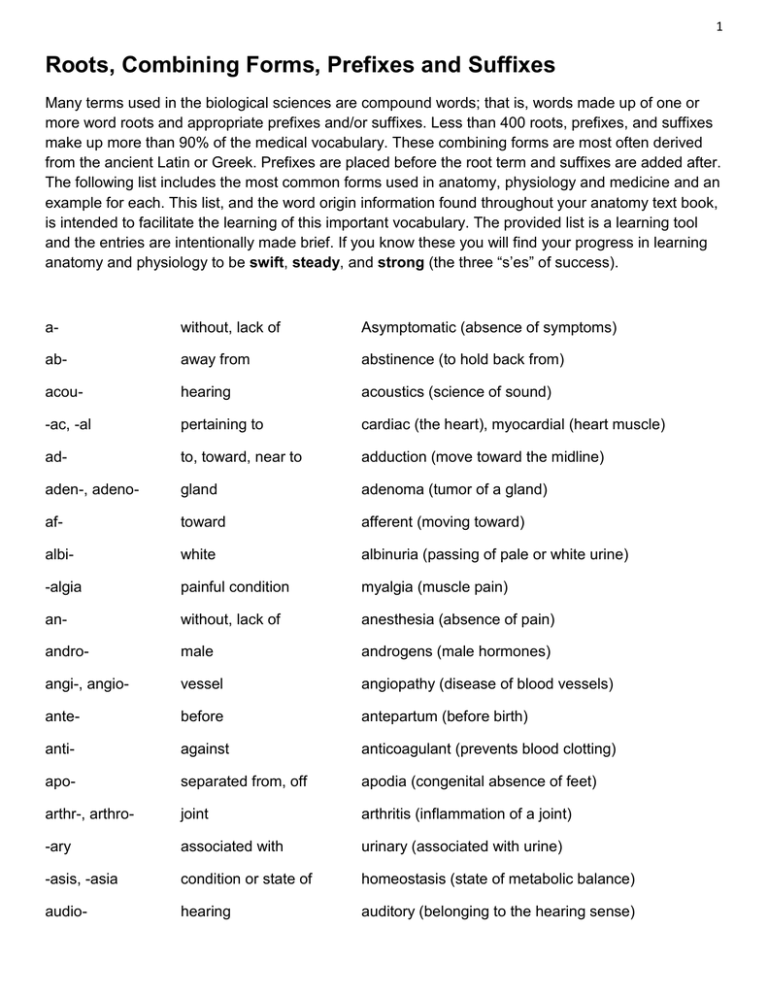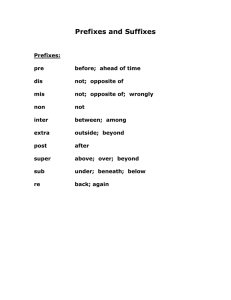Anatomy & Physiology: Roots, Prefixes, Suffixes Reference
advertisement

1 Roots, Combining Forms, Prefixes and Suffixes Many terms used in the biological sciences are compound words; that is, words made up of one or more word roots and appropriate prefixes and/or suffixes. Less than 400 roots, prefixes, and suffixes make up more than 90% of the medical vocabulary. These combining forms are most often derived from the ancient Latin or Greek. Prefixes are placed before the root term and suffixes are added after. The following list includes the most common forms used in anatomy, physiology and medicine and an example for each. This list, and the word origin information found throughout your anatomy text book, is intended to facilitate the learning of this important vocabulary. The provided list is a learning tool and the entries are intentionally made brief. If you know these you will find your progress in learning anatomy and physiology to be swift, steady, and strong (the three “s’es” of success). a- without, lack of Asymptomatic (absence of symptoms) ab- away from abstinence (to hold back from) acou- hearing acoustics (science of sound) -ac, -al pertaining to cardiac (the heart), myocardial (heart muscle) ad- to, toward, near to adduction (move toward the midline) aden-, adeno- gland adenoma (tumor of a gland) af- toward afferent (moving toward) albi- white albinuria (passing of pale or white urine) -algia painful condition myalgia (muscle pain) an- without, lack of anesthesia (absence of pain) andro- male androgens (male hormones) angi-, angio- vessel angiopathy (disease of blood vessels) ante- before antepartum (before birth) anti- against anticoagulant (prevents blood clotting) apo- separated from, off apodia (congenital absence of feet) arthr-, arthro- joint arthritis (inflammation of a joint) -ary associated with urinary (associated with urine) -asis, -asia condition or state of homeostasis (state of metabolic balance) audio- hearing auditory (belonging to the hearing sense) 2 auri- ear auricle (ear-shaped structure) auto- self autolysis (self breakdown) baro- weight, pressure baroreceptor (receptor for pressure changes) bi- twice, double bicuspid (two cusps) -blast germ, bud chondroblast (cartilage-producing cell) brachi- arm brachial (of the arm) brady- slow bradycardia (slow heart rate) bucc- cheek buccal cavity (inside cheek region) carcin- cancer carcinogenic (causing cancer) cardio- heart cardiology (study of the heart) caud- tail caudal (by the tail) cephal- head cephalic (by the head) cerebro- brain cerebrospinal (of the brain and spinal cord) chondro- cartilage chondrocyte (cartilage cell) -cide kill spermicide (agent that kills sperm) circum- around circumduction (movement forming a circle) -clast break osteoclast (cell that breaks down bone) co-, com- with, together cooperate, gray commissure (connects rt/lt horns) contra- against, opposite contralateral (opposite side) cost- rib intercostals (between the ribs) crani- skull cranial cavity (where the brain is located) cune- wedge cuneiform (wedge shaped) cuti- skin subcutaneous (under the skin) cyan- blue color cyanosis (bluish discoloration of skin) cysti-, cysto- sac, bladder cystoscope (instrument for examining inside of bladder) -cyte, cyto- cell erythrocyte (red blood cell), cytology (study of cells) demi- half costal demifacet (half-moon facet on vertebra for rib 3 articulation) di, diplo- two diploid (two sets of chromosomes) duct-, -duct lead, draw ovarian duct, adduct (toward midline of body) dur- hard dura mater (tough menix of CNS) dys- painful, difficult, bad dysuria (painful urination) e-, ec-, ef-, ex- out, from efferent (carries away from), excretion (eliminate) ecto- outside, outer ectocardia (displacement of heart) -ectomy to cut out appendectomy (removal of appendix) ede-, -edem swelling myoedemia (muscle swelling) -el, -elle small organelle (tiny structure that performs cell function) endo- within endocardium (lining within heart chambers) entero- intestine enteritis (inflammation of intestines) epi- above, on epicardium (membrane covering heart) ex-, exo outside exhale (breathe out); exocrine (gland the secretes to the outside) extra- outside extracellular (outside the cell) -ferent carry afferent (carries toward) -form resembling, shape of fusiform (spindle-shaped) gastr-, gastro- stomach gastric ulcer (stomach ulcer) -genesis, -genic produce, origin gluconeogenesis (glucose from another molecule), carcinogenic (causes cancer) gloss-, glosso- tongue hypoglossal (under the tongue) glyco- sugar, sweet glycolysis gyn- female, woman gynecology (treatment of female reproductive organs) haplo- single haploid (single set of chromosomes) hem-, hemato- blood hematology (study of blood) hepato- liver hepatitis (inflammation of the liver) hetero- different heterosexual (involving different sexes) 4 hist-, histo- tissue histology (study of tissues) homo-, homeo- same homeostasis (constancy of body parameters) hydro- water hydroadipsia (absence of thirst for water) hyper- above, over hypertrophy (overgrowth of cells or part) hypo- under, below hypoglycemia (low blood sugar) idio- self, distinct idiopathic (disease of unknown cause) infra- below infraspinatus (below the spine of scapula) inter- between interosseous (between two bones) intra- within intracellular (within the cell) -issimus greatest latissimus (widest) iso- equal, same isotonic (same concentration) -itis inflammation neuritis (inflammation of nerve) juxta- near juxtaglomerular (near the glomerulus) labi- lip labia major (thickened folds of skin in female external genitalia) lacto- milk lactose (milk sugar) leuko- white leukocyte (white blood cell) lip- fat liposuction (removal of fat from an area) -ology study of urology (study of urinary system -lysis breaking up, dissolve hemolysis (breaking up erythrocytes) macro- large macrophage (certain large leukocyte) mamm-, mast- breast mammary glands, mastectomy (breast removal) medi- middle medial (towards the midline) melano- black melanocyte (dark pigment-producing cell) -mers, -meres parts polymers (larger molecules made of monomers) meta- after, beyond metastasis (beyond the original position) micro- small microorganism (very small organism) 5 mono- single, one monomer (a single part); monosaccharide (a simple or single sugar) morph- form, shape morphology (study of shape) myo- muscle myometrium (muscular wall of uterus) necro- dead necrotic (dead tissue) neo- new neonatal (newborn) nephro- kidney nephrology (study of kidneys) neuro- nerve neurilemma (nerve cell membrane) oculo-, ophthalm- eye oculomotor (movement of eye), ophthalmology (study of the eye) odonto- tooth odontoid (shaped like a tooth) -ole little arteriole (small artery-like vessel) oligo- few, little, deficient oliguria (little urine output) -oma tumor carcinoma (cancerous tumor), osteoma (benign bone tumor) oo- egg oocyte (egg cell) -osis condition of osteoporosis (having bones that are porous) osse-, osteo bone osteoblast (bone-forming cell) oto- ear otogenic (originating within the ear) para- near, beside paranasal (by the nose) -pathy disease neuropathy (nerve disease) pelv- basin renal pelvis (collection area in kidney) -penia deficiency leucopenia (deficiency of leukocytes) peri- around periosteum (membrane covering bones) phag- eat phagocytosis (cellular eating) phil- have an affinity for lipophilic (associates with fat) -plegia paralyze, stroke paraplegia (paralysis of lower extremities) pneumo- air, gas, lungs pneumothorax (air in the pleural cavity) 6 -poiesis make, formation of erythropoietin (hormone that stimulates erythrocyte production) poly- many polycythemia (excess erythrocytes) post- after postnatal (after birth) pre- before in time, place prenatal (before birth) pro- before in time, place prosect (to cut for demonstration) pseudo- false pseudostratified (not truly layered) quad- fourfold quadriceps femoris (4-headed muscle of anterior thigh rami- branch ramus (primary division of a nerve) rect- straight rectus abdominis (straight muscle of abdomen) reno- kidney renal (of the kidney) retro- backward, behind retroperitoneal (posterior to the peritoneum) sclera- hard arteriosclerosis (hardening of the arteries) semi- half semilunar (half-moon shaped) serrate- saw-edged serratus anterior (muscle of thorax) somato- body somatotropin (growth hormone) steno- narrow stenosis (narrowing of opening) sterno- breast, chest sternum (bone over heart and medial to ribs) stria- stripe striated (showing stripes or lines) sub- under subcutaneous (under the skin) super-, supra- above, upper supercilia (upper brows), suprarenal (superior to the kidney) sym-, syn- together, with symphysis (growing together, synapse (where neurons, or neuron and muscle fiber, meet) tachy- fast tachycardia (rapid heart rate) therm- heat thermometer (tool to measure temperature) thorac- chest thoracic cavity (body cavity containing heart, lungs) thrombo- blood clot thrombocyte (platelet) 7 -tomy cut, incise appendectomy (removal of appendix) topo- place, position ectopic (being out of position) trans- across transdermal (across the skin) tri- three triceps brachii (three-headed muscle) -tropic influencing gonadotropic (effecting the gonads) tunica- layer, coat tunica interna (inner part of blood vessel) ultra- beyond, excess utlradian (more than every 24 hours) uni- one unicellular (single cell) -uria urine polyuria (excess urine) vas- vessel vasodilation (widening of lumen of blood vessel) vertebra- spine vertebrae (bones of the spine) villo- hair microvilli (minute projections of cell membrane) viscer- internal organ visceral (of the internal organs) zyg- yoked, paired, union azygos (unpaired anatomical structure)


